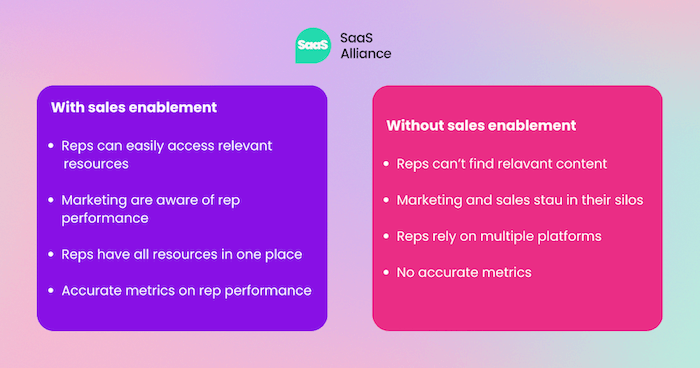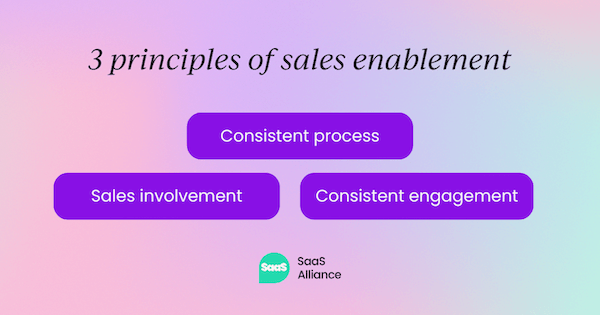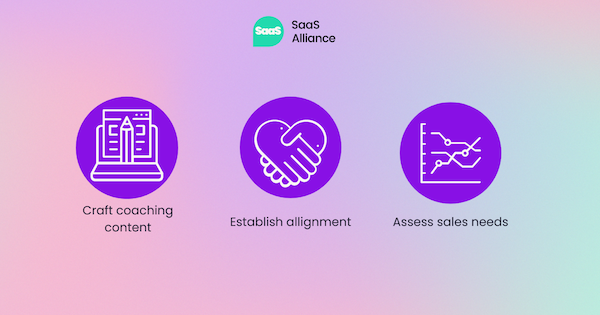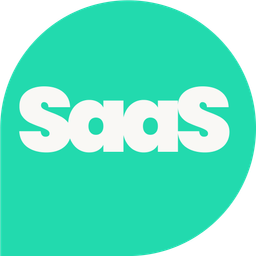Think of your sales team as your front line army, charged with championing your product to prospects, but if they don’t have the right tools or resources, they’re going to fall short of their objectives.
A solid sales enablement strategy can increase sales, but there are many vital aspects that need to run smoothly in order for that to be a reality.
Here, we guide you through the essential tenets of sales enablement, how it benefits your SaaS business, and how to build the ultimate sales enablement strategy for success.
Let's break down our agenda here:
- What is sales enablement?
- Why is sales enablement important?
- Who owns sales enablement?
- The three guiding principles of sales enablement?
- What is a sales enablement tool?
- Best practices for sales enablement
What is sales enablement?
Sales enablement is the driving force behind your sales team, ensuring that your team operates under a top-notch sales methodology by providing guidance and training wherever needed.
But what does sales enablement look like? It’s the perfect synergy between ideation and execution, ensuring the creative strategies hatched from the mighty brains of your marketing team are carried through in your sales team’s execution.
In order for your sales team to be proactive and motivated, it’s essential they’re empowered by true alignment with the other departments within your org, and this is what sales enablement provides.

What’s the difference between sales enablement and sales operations?
It’s easy to confuse these two functions, especially since they are both concerned with the success of sales teams, but their two roles differ in some pretty fundamental ways.
Sales enablement is all about providing sales reps with the tools and resources they need to seal deals, while sales operations focus on overseeing the sales process and monitoring results. When goals aren't aligned, it can lead to conflicts and misunderstandings between these two teams. For this reason, it’s important that the two functions have their respective roles clearly outlined.
Here’s a breakdown of the ways sales enablement empowers your sales team:
- Helping sales teams find the content they need, when they need it.
- Offering versatile methods for salespeople to share and present their content.
- Giving instant insights into how customers are interacting with content in real-time.
- Using sophisticated analytics to fine-tune sales strategies.
- Providing sales teams with the training and advice they need to succeed.
- Tracking everything to see how it affects overall sales results.
Why is sales enablement important and what are the benefits of sales enablement?
Sales enablement is important because it can considerably boost the performance of your sales reps. It ensures they have the resources and training materials they need to engage with prospects on a human level. With high level training, prospects are able to establish that foundation of trust that leads to fruitful relationships and consolidates the reputation of your brand.
Without a sales enablement strategy, you can leave your org at a disadvantage.👇

Here, we delve into the benefits in more detail.
1. Better tools at your disposal
Sales reps need holistic profiles of their prospects if they’re to close deals and ensure new customers have a positive impression of your org. Sales enablement software such as Guru and Seismic give sales access to essential data on their prospects, including pain points, challenges, and industry.
2. Sales enablement empowers reps to close deals faster
Being trained and having access to training resources means that reps can go into pivotal conversations with the skills they need to quickly appeal to user pain points. The length of the sales cycle can be costly, and sales enablement can help to mitigate these costs.
3. Sales enablement leads to better alignment within the org.
Sales enablement relies on input from marketing and your senior stakeholders. As a result, sales reps who are thoroughly trained are in touch with the needs of your other departments. In order for sales reps to give the best representation of your org to prospects, reps need to have a firm understanding of what your company’s mission is really about and of your product’s vital benefits.
4. Sales enablement boosts your brand reputation
By facilitating great relationships with prospects, sales enablement ensures a positive experience at every sales-owned touchpoint, boosting referrals, and meaning conversions are never far away.
Too often, we become fixated on short term success, but by raising the reputation of your reps, and your brand as a whole, you seal the deal for long-term success. And prospects who failed to convert the first time might think of you again in the future.
For more on this, check out sales veteran Sara Storm’s thoughts on the long term possibilities of sales enablement.
Who owns sales enablement?
Sales enablement only works when the responsibilities and roles are clearly defined. In the interests of alignment it’s important that everyone knows what their role is and how it’s going to impact the business. We’ve outlined the roles that usually constitute a sales enablement strategy here.
The three guiding principles of sales enablement
Although sales enablement is never going to look exactly the same from one org to the next, there are some essential foundational aspects of sales enablement that hold true across all organizations.
We dive into them below,.but if you’re a bit strapped for time, we’ve compiled this nifty infographic:

Principle 1: Establish a consistent sales enablement process
This is a holistic process, requiring input from multiple teams. Your sales methodology should be in line with the kind of product you're offering and its target demographic. This is why you need to have input from marketing and the senior stakeholders within your org.
Establishing a firm and consistent process ensures a consistent standard across your whole org. You can’t expect to uphold standards unless you have a standard established.
Principle 2: Get your sales team involved in the sales enablement process
Developing and refining sales readiness demands that you give your sales team the skills necessary to make your new sales enablement program a success. After all, your sales team is going to be responsible for executing on this vision.
Sales enablement will need to ensure they have the content, training programs and assessment tools they need to reach expectations.
Principle 3: Encouraging engagement and consistent outreach
It can be easy for sales reps to adopt the mindset that once you make a sale it’s a one and done, but increasingly, in the SaaS landscape, it becomes more and more important to engage with the customer or prospect throughout the sales cycle.
Sales enablement, through the implementation of resources, encourages this mindset of continuous excellence.

What is a sales enablement tool?
Sales enablement technology has come a long way, and incorporating it plays a vital role in boosting the win rate of your sales reps. The ideal modern sales enablement tool is holistic, encompassing the following:
- Training resources (content).
- Workflows between teams.
- Analytics on how the resources are used.
- Guidance centered around context.
These tools will provide key insights on how content is influencing sales success, which content reps are sending to prospects, and the influence that content is having on prospects converting or not.
Sales enablement tools make it easier to facilitate alignment between sales, marketing, and sales enablement needed for success. Let’s dive into some of the more common characteristics found in sales enablement tools.
Searching for success
Rather than scrambling fruitlessly for relevant resources among peers, sales enablement tools can make it easier by making all relevant content easier to locate. The goal is that whatever problems sales reps are encountering, they can simply input the query into the tool, and they can find content or guidance to match that query.
Recommendations based on performance
Sales enablement tools will analyze content based on how successful it is at converting customers, and will make recommendations accordingly. It will even analyze how successful certain resources are at producing conversions at specific points in the sales cycle, or on the particular problem you're dealing with.
Taken together, this means that sales enablement tools are constantly analyzing the efficacy of your content, meaning you can optimize and iterate over time.
Content training and coaching for sales reps
Even the most seasoned sales professionals can improve. Sales enablement tools equip reps with playbooks to aid them with any particular problem they might encounter in their day-to-day processes.
This means that reps can take a self-guided approach to their own learning, circumventing strategies they’ve already mastered and honing in on those resources that address the issues they’re still struggling with.
Transform successful practices into daily habits
A sales enablement platform ensures that sales training isn’t just a one and done, and reps can return to resources they find useful to refresh their knowledge and consolidate those newly won skills.
By having a permanent resource at their disposal, these practices soon become common habits and your reps are able to close deals on a broader scale.
Best practices for sales enablement
Let’s end with a few best practices for sales enablement in SaaS. No matter what kind of organization you’re running, these are the guiding principles that hold true across the whole industry.

- Try out new selling tactics by putting more focus on sales training and onboarding.
- Get a clear picture of what the sales team needs to better tackle customer inquiries and issues.
- Bring the marketing and sales teams together to work on content creation.
- Craft content that blends insights from marketing analytics with the sales reps' direct experiences from conversations.
With these strategies front of mind, you’ll be on your way to sales success and sustainable growth for your SaaS organization.
Like what you see? Why not sign up for exclusive insights from the leading minds in SaaS with a SaaS Alliance membership plan?



